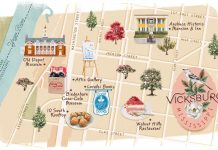
Monmouth Historic Inn
I arrive at the inn after midnight. Monmouth, perched atop a hill and surrounded by giant oaks, glows white in the moonlight. As I pull into the drive, deer scamper in front of my headlights. There’s something ghostly about the Greek Revival mansion before me, built in 1818 on twenty-six acres of forest. It’s a place where slaves once lived and where John Quitman, the nineteenth-century Mississippi governor, drew his last breath.
I retrieve my key, make my way through the garden, and enter a cottage behind the mansion. My suite, Live Oaks, was named in honor of Quitman’s sugar plantation in Louisiana. Indeed, it feels like a room in which Quitman himself might have stayed, with a canopied bed, a fireplace, and gold-framed period paintings.
In some respects, the story of this estate parallels that of its hometown, Natchez. Both knew great wealth before the Civil War, and both were devastated after it ended. And were the war not enough, a boll weevil invasion in the early 1900s effectively stopped the clock on their development. Natchez rebounded first, recognizing the value of its historic homes in the 1930s and spearheading preservation efforts that would eventually make it one of the most visited cities in the state. Monmouth took a bit longer: After Quitman’s beleaguered heirs finally sold the estate in the 1920s, it languished in disrepair until 1978, when it was renovated and opened as a bed and breakfast. In 2012, Nancy and Warren Reuther assumed ownership, outfitting the inn’s thirty rooms with antebellum furnishings, many of which belonged to the Quitmans. Today, rooms are booked six months out.
After spending the day touring Monmouth, the aromas from the inn’s Restaurant 1818 lure me to dinner. Quitman once entertained Jefferson Davis here, sitting with him beneath the very same Waterford-crystal chandeliers. The adjacent Quitman Lounge displays Quitman’s personal letters to Robert E. Lee, the kerchief with which he rallied his troops during the Mexican-American War, and the crystal decanter set that accompanied him into battle. Following dinner, the longtime barkeep, Roosevelt Owens, prepares one of his signature mint juleps for me. The cocktail, made with a secret family recipe, is good—so good, it once inspired the Kentucky governor to name Roosevelt an honorary colonel.
I bid farewell to Roosevelt and wander into the garden to stare at the star-filled sky. It’s said Quitman’s ghost still roams these grounds, and in the calm breeze of the night, I faintly sense his spirit.
36 Melrose Avenue, Natchez, Mississippi, 601-442-5852, monmouthhistoricinn.com
While You’re There
Natchez Burning
Natchez’s Rhythm Club caught fire on April 23, 1940, during a concert by big band leader Walter Barnes. More than 200 people—including Barnes and nine members of his orchestra—were killed in the blaze, and the disaster became a major touchpoint in the history of blues music. Today, the site is a part of the Mississippi Blues Trail and houses a small museum. rnconsitemm.org
Spring Pilgrimage
The Natchez Pilgrimage was born in 1932, when a late freeze derailed a garden tour organized by the Natchez Garden Club. To salvage the event, the town’s leading ladies pulled together an impromptu tour of local antebellum homes. The rest, as they say, is history. This year’s event—from March 5 to April 5—coincides with Natchez’s tricentennial and promises to be the biggest yet. natchezpilgrimage.com

















